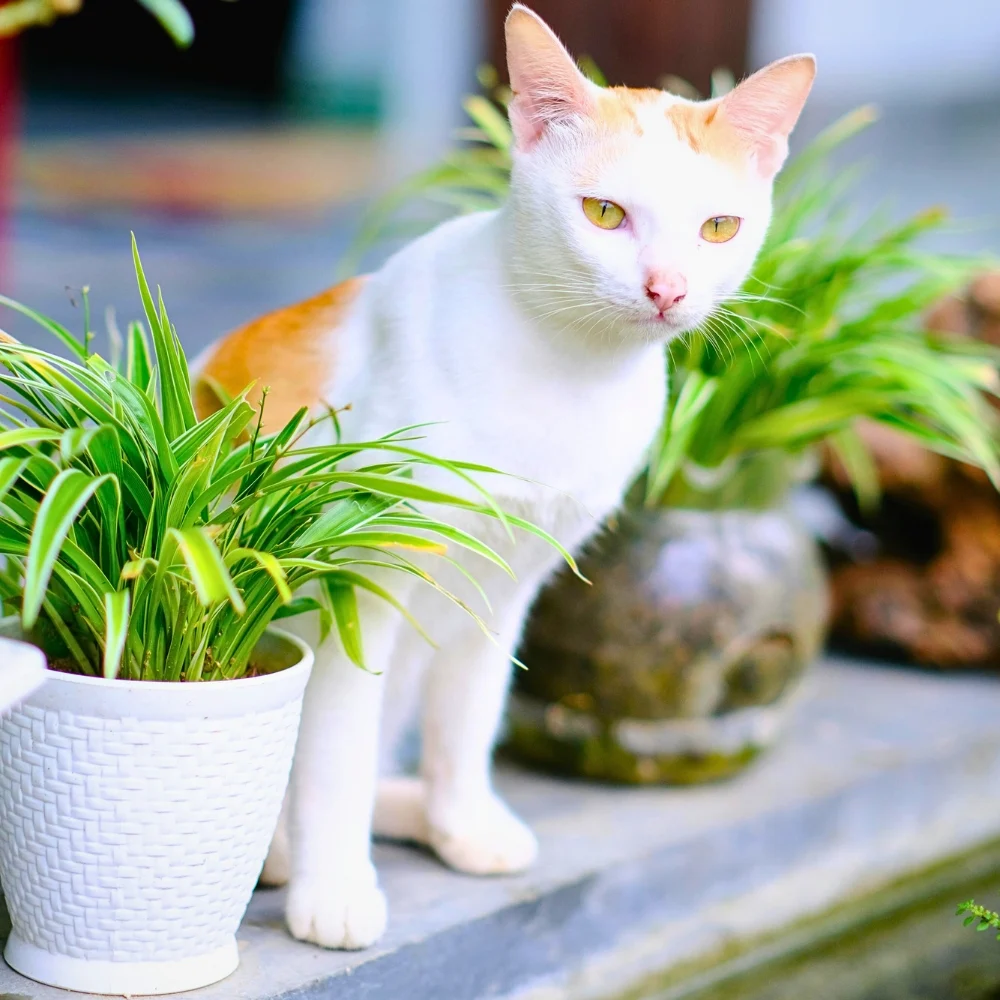The Foxtail palm tree is a tropical beauty. It is widely adored, beautifies, and fits different landscape designs worldwide. Grown outdoors in a tropical garden or indoors, this palm tree's graceful presence is owed to its lush green fronds, which resemble a fox's tail.
Its popularity in the landscaping world has been attributed to its elegant appearance combined with its low maintenance and caring demands. Whether you are a seasoned plant lover or a novice, the foxtail palm tree will not give you immense trouble, whether grown indoors or outdoors. Here is a comprehensive guide on how to develop and care for a foxtail palm tree.
About Foxtail Palm Trees
Foxtail palm's botanical name is Wodyetia bifurcata. It belongs to the species of palm trees in the Arecaceae family. The foxtail palm plant grows at least 1 foot annually, attaining maturity within two decades.

When fully mature, the foxtail palm should achieve a maximum height of 30 ft and a width of 20 ft. Ideal for USDA zones 10 to 11, this palm prefers sunny and humid conditions to grow optimally. Foxtail palm trees when grown indoors can reach a maximum height of 15 ft and a width of 8-10 ft. Ensure their surroundings are not limited to avoid blockage or inhibition of their growth indoors.
Origin and History of Foxtail Palm Trees
Originally Foxtail Palm tree was discovered in Queensland, Australia. In the US it can be grown in the tropics and subtropics under zones 10 to 11, in full to partial sun exposure. Its botanical name, Wodyetia bifurcata pays homage to Wodyeti, an aboriginal bushman from the palm's native region, and bifurcataa refers to the palm's distinctively forked fronds.

Since its discovery in the late 1970s, the foxtail palm has traversed different regions globally, winning the hearts of garden lovers with its striking appearance. The foxtail palm plant is adaptative to diverse climatic conditions and even in the face of challenging climate conditions, its resilience comes to life.
Its incredible ornamental value has cemented the Wodyetia bifurcata's position in tropical and subtropical landscapes.
Benefits of Growing Foxtail Palms
Apart from the elegance it adds to any landscape, its lush dark green presence makes it a desirable garden palm species. The fresh new fronds of foxtail palms resemble a fox's tail and have a compact structure. When fully formed or mature, they form a canopy shade, providing perfect shade and a breeze to unwind, especially during sunny and hot days.

Air purification benefits cannot be overlooked; with its fronds, the foxtail palm can help alleviate the effects of CO2 emissions by absorbing it and releasing oxygen in return. The palm is non-toxic, making it safe to be grown in homes, though its seeds can be toxic when ingested, so be on the lookout for your pets and children to avoid any harm from this tropical plant.
Foxtail Palm Varieties
The foxtail palm is the only variety available in the genus Godetia, which comes from the family of Arecaceae palms. There are no other varieties or different types of foxtail palm trees known at this moment.
You can read about other palm tree varieties that we have covered including the Sago Palm and the Queen Palm trees.
Planting Foxtail Palm Trees - Understanding the Process
The foxtail palm plants in large sizes can normally be purchased from a nearby garden landscaper or large garden center, to speed up beautifying your landscape in no time. Though the planting process is not complicated, it is crucial to get it right from the onset to give your foxtail palm plant a head start. The foxtail palm tree’s striking aesthetics and self-cleaning nature make it a standout choice in tropical and subtropical garden design. According to one of the landscaping specialists at JPK Landscaping, “Foxtail palms are ideal for creating effortless elegance in any outdoor setting—whether framing a driveway or anchoring a poolside layout, their low-maintenance structure and lush form bring instant visual impact without constant upkeep.” Their adaptability and dramatic silhouette make them a popular request among clients seeking modern yet naturalistic landscaping solutions.
Choose a place with full sun exposure. The palm tree does well in warm climatic conditions, so tropical landscapes or regions are ideal, but the subtropics can also suffice. Avoid any structures or tall trees that may block your foxtail palm tree from growing optimally. If planting indoors, choose a pot that is well-draining and can accommodate and support the growth of this palm tree.

If you reside in a windy region, ensure there are strong windbreakers like a wall to protect your young foxtail palm plant from any damage. Since the foxtail palm tree can grow up to 30 ft, and 20 ft wide, ensure the surrounding space is enough to accommodate the same.
Caring For Your Foxtail Palms
The Wodyetia bifurcate are pretty low-maintenance palm trees that are not demanding to grow and care for. The right sunlight, soil mix, watering, and stable weather conditions are enough for this palm to thrive. Its self-cleaning habit means the dead or damaged fronds can fall off independently, requiring less pruning.

They have moderately salt-tolerant traits and can grow in the coastal region. Indoors, you can effortlessly grow it, given that you mimic the tropics or subtropics climatic conditions. Lots of watering is ideal initially, but once established, the Wodyetia bifurcata can withstand moderate drought or dry periods.
Foxtail Palm Care - Understanding Light Requirements
Native to the tropical region, foxtail palm trees thrive in plenty of sunlight exposure. It is ideal to plant your foxtail palm in places with full sun to partial shade throughout the day. Please note that it can be challenging for foxtail palms to grow indoors if access to natural sunlight cannot be guaranteed.
Foxtail Palm Care - Soil and Water Needs
Good soil is vital to growing a healthy and thriving Wodyetia bifurcata. A well-draining soil with a pH of 5 to 7, rich in organic matter, is a necessity! If planting in a pot, choose a potting mix that allows for water to drain quickly.

During the growing season, regular watering is a requirement, as this tropical plant loves humidity. However, ensure the soil is moist and not soggy. Excessive watering can easily cause root rot, as these plants are drought-tolerant and do not demand excessive water for survival. Ideally, water deeply once a week, depending on the weather conditions. If everything is stable, then once a week is more than enough for this plant.
Fertilization Tips to Grow Foxtail Palms Better
Consistent fertilization contributes to healthy growth. Use a high-quality palm fertilizer that contains micronutrients. Apply it monthly during the growing season.

Avoid fertilizer application during the winter, when your palm is inactive.
Foxtail Palm Care - Pruning and Maintenance
Naturally, foxtail palm trees have self-cleaning traits, and dead or aging fronds can peel off on their own, meaning that they can heal themselves from common crown rot issues. However, regular pruning using a clean pair of pruning shears can still improve the appearance and beauty of your palm tree.
Propagating Foxtail Palm Tree
The propagation of foxtail palm trees is an easy and rewarding experience for any gardener. One can propagate foxtail palms through seeds or the division of mature palms. Seed propagation is common and the most used method. Collect ripe fruits from your palm. The fruits are red to orange in color and clustered.
Soak the fruit containing seeds in water for days to soften it, making it easier to extract the seeds. Upon extraction, prepare a well-drained, rich-in-nutrients potting mix. Plan your seeds in the potting mix and water them regularly.

However, ensure the pot is placed in a warm, bright spot away from direct sunlight. Covering the pot with a plastic bag can help retain moisture. If the above conditions are met, the seeds should germinate in 2-12 months.
Propagating through the division of mature palms is best done during winter or early spring before the growing process resumes. Dig up the plant foxtail palms to identify offsets and suckers emanating from the base and roots of the tree, respectively. Separate the offsets and suckers from the parent palm. Plant the young offsets and suckers in the new potting mix, water regularly, and keep it in a bright and warm spot but away from direct sunlight. In a few weeks, your young foxtail palms will grow well.
Common Pests and Diseases Associated with Foxtail Palms
Few palms are as remarkable and eye-catching in landscaping as the Foxtail Palm. It is understandable why this palm has become a mainstay in many tropical and subtropical areas, given its distinctive, bushy fonds and towering height. But just like any other palm plant, it is vulnerable to illnesses and pests that, if ignored, can do serious harm.

- Common Pests
A prevalent pest that may pose a threat is the palm leaf skeletonizer. This bug, which feeds on palm leaves, can seriously harm an area if it becomes overly infested.
Your palm's leaves may have developed big holes and areas of missing tissue, appearing torn and ragged. If you believe your palm has become infected, it's critical to take immediate action to stop the spread of palm skeletonizer.
Spider mites are another pest that can harm your palm. Although it is difficult to see these tiny insects with the unaided eye, you might notice that your palm's leaves have developed tiny, yellowish dots all over them.
Because spider mites feed on the sap from leaves, over time, the leaves may droop and eventually die. Another common bug that can harm your palm is scale insects. If the infestation is severe, these insects, which feed on the sap of the rotting leaves, can do a great deal of harm. Your foxtail palms may also be impacted by other pests, such as mealybugs, ambrosial beetles, banana moths, and whiteflies.

Keep your palm well-watered and fertilized to avoid pest infestations. A palm in good health is less vulnerable to attacks.
- Diseases
For this palm, fungal infections can also be an issue. Ganoderma root rot is one of the most prevalent illnesses that can permanently harm a palm's base and roots.
This disease is caused by a particular kind of fungus that targets palm roots and causes them to rot and decay. If treatment is not received, the palm may collapse and die from Ganoderma root rot. To prevent fungal diseases and related illnesses, make sure to plant your palm in well-draining soil and refrain from overwatering. The ideal soil temperature for foxtail palms is damp but not soggy, so finding the ideal balance is crucial.
Using Foxtail Palm Trees in Landscape Design
The foxtail palm tree is renowned for its striking presence in landscape design. It functions as a dramatic focal point in any garden or outdoor space. With its smooth gray trunk and big tufted fronds, this tropical showstopper creates a stunning visual contrast against the backdrop of your garden.
These plants are ideal for outdoor growth as they demand higher exposure to the sun, which can be a constraint when planting them indoors.

Foxtail palm stands out due to its unique bushy tail-like fronds. They are perfect for creating a tropical oasis effect, enhancing the garden's theme with its verdant, and lush foliage.
For an added layer of sophistication, you might choose multi-trunk specimens of foxtail palms. These offer a more textured look with their natural curvature and structure to create an appealing contrast with other plants and hardscape elements.
Header Image by @Gowthami Nursery Featured Image by @Rob Woodman










